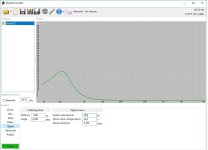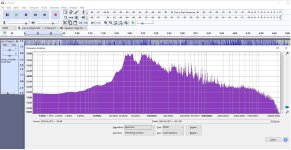@LOMAXINGTONSTEEL What is the make and model of the 500W BASH plate amplifier that you are planning to use? I am curious as to what its filtering and EQ capabilities might be.The amp is a 500w BASH plate amp. I'll set the HPF to 20 Hz.
Indeed. My sealed 18" enclosures are 55l.However, their enclosures are likely to be quite a lot larger, unless sealed enclosures are chosen.
@LOMAXINGTONSTEEL What is the make and model of the 500W BASH plate amplifier that you are planning to use? I am curious as to what its filtering and EQ capabilities might be.
It's an O-Audio amp. I can't see a model number on it anywhere but was told that its 500w.
Last edited:
You will lose a few dB of output and increase distortion, but not so you would notice, and also depending on if you plan to run them to their absolute maximum output capability, which is never, EVER a good idea. Big output requires big cone area; how did you choose the Dayton driver, and how much is it?
Move a Lot of Air - GENTLY!
I was given it by a friend when they moved out of the country 🙂
.....or just 'critically' damp it.Round is certainly the most efficient, but for those of us that prefer moving towards aperiodic, the high aspect ratio ducts are the way to go. 😉
Attachments
I'd go with 4" round port as long as you can fit the pipe length of about 45cm. Much easier to built and flexible to tune. Just keep in mind this pipe will resonate at around 390Hz (you can use a LPF to cut before) and will take about 3.5 liters from your box.
It is expected to sound really cool (FR down to 24Hz @ -3dB on simulation) and powerful.
A 4" port pushes the port air velocity up to 27.5 m/s. Won't this be way too high? I thought under 17.5 m/s was required.
That driver in 80L performs well. I would just change to a round port and do the final port length tuning by measurement after it's built. I always make my ports removable initially to make adjustments. Your port has 2 curves and a poor aspect ratio which will perform worse than the good ol pvc pipe.
Do you have any advice for measuring and adjusting a tube port? What equipment / software should I be looking for?
I don't understand. I'm a bear of very little brain.See my recent post. 😉
You get more friction with high aspect ratio slot ports; you also have 2 turns, which cause tumbling and extra turbulence, It is very hard to avoid chuffing with this style of port.With the slot port, do he dimensions matter if the air velocity remains below 17.5m/s?
It will take more experimentation, but if you port out the bottom with a power-port style port you may be able to achieve something much better with a straight round port. Put a port dead center on that panel. Put a generous flare on it and put a board an inch or two below the bottom to act as a diffuser to all sides. The port up the center of the box should also have a flare on the inside. Look up Polk's Power-Port Concept.
Well-said Ron E. The entry and exit geometry of the port should have equalised airflow where possible to avoid port rectification, for instance by adding a flare on the baffle only, as many manufacturers and DIYers do. A flare and vestigial baffle on the port end inside the box is a good plan.
Hi! Yes, you are right! But the peak velocity of 27m/s will be around 21Hz. From 30Hz up, the air velocity will be under 18m/s with 200W. Unless you listen to things with a lot of energy below 30Hz, it's ok. In general music listening, even the records with a lot of bass (funk/R&B/HipHop etc), you'll not have all the 200W concentrated below 30Hz. But, you have make an analysis of your case and decide how to move forward.A 4" port pushes the port air velocity up to 27.5 m/s. Won't this be way too high? I thought under 17.5 m/s was required.
Attachments
90's era jungle, proto-dubstep, dub and dub techno vinyl. So definately low end heavy. I'm sure plenty below 30 Hz but not sure how much. Is there anyway of modeling how a flared port will compensate for a higher port air velocity?
What's your room size and expected listening level? (Sorry if I've missed it...).90's era jungle, proto-dubstep, dub and dub techno vinyl
With these genres of music you could run out of bass very quickly with a little single 12" sub!
@LOMAXINGTONSTEEL Regarding the flares, I don't know how evaluate them. Let's see what others comment about it.
If you want to have an idea of how much bass a song have in a certain frequency range, you can use Audacity (open source sw) and make a spectrum analysis.
See an example of the type of music I listen to which has a lot of bass, but as you can see not much energy below 30Hz. Sure lots of harmonics below 30Hz.
Keep in mind that in order to achieve 27m/s you need 200W concentrated in a single 21Hz sine wave without any harmonics.
Music, in general, has tones with lots of harmonics.
If you want to listen to the song which I used as the attached spectrum analysis, just to compare with the songs you listen too, search Youtube the artist "Paula Lima" and the song "Tive Razão" - Brazilian artist.
If you want to have an idea of how much bass a song have in a certain frequency range, you can use Audacity (open source sw) and make a spectrum analysis.
See an example of the type of music I listen to which has a lot of bass, but as you can see not much energy below 30Hz. Sure lots of harmonics below 30Hz.
Keep in mind that in order to achieve 27m/s you need 200W concentrated in a single 21Hz sine wave without any harmonics.
Music, in general, has tones with lots of harmonics.
If you want to listen to the song which I used as the attached spectrum analysis, just to compare with the songs you listen too, search Youtube the artist "Paula Lima" and the song "Tive Razão" - Brazilian artist.
Attachments
3 x 6 x 3.5 metres. It doesnt need to be earth shatterringly loud, but enough to get the blood pumping. It's my office/workshop. I'm quite limited in terms of placement. I've basically got two work surfaces, one on each long wall, and a 58 x 44 x 80 cm spot for the sub in the middle of one wall which is 3m directly opposite the wall that my turntables are against. The stereo speakers I have are a pair of Kef Caprice II and a couple of DIY bookshelf Azaph Audio designs. I do have another 12" driver if needed but that needs a 200l box so trying to get this to work for now. 🙂What's your room size and expected listening level? (Sorry if I've missed it...).
With these genres of music you could run out of bass very quickly with a little single 12" sub!
Last edited:
@LOMAXINGTONSTEEL Regarding the flares, I don't know how evaluate them. Let's see what others comment about it.
If you want to have an idea of how much bass a song have in a certain frequency range, you can use Audacity (open source sw) and make a spectrum analysis.
See an example of the type of music I listen to which has a lot of bass, but as you can see not much energy below 30Hz. Sure lots of harmonics below 30Hz.
Keep in mind that in order to achieve 27m/s you need 200W concentrated in a single 21Hz sine wave without any harmonics.
Music, in general, has tones with lots of harmonics.
If you want to listen to the song which I used as the attached spectrum analysis, just to compare with the songs you listen too, search Youtube the artist "Paula Lima" and the song "Tive Razão" - Brazilian artist.
Thank you for posting this. It has really opened my eyes. This Tive Razão tune is pretty cheeky too!
Below are two recordings through a Native Instruments Kontrol Z2, no amp just straight to the PC. (YouTube links for reference) It's a good example of what I'm working with.
Loefah - Mud
Shackleton - Blood On My Hands
Hi! Looking at the spectrum of your tunes and listening from YT, I can see/hear a lot of energy below 30Hz and kind of pure signals sweeping wildly between 20 and 30Hz. It is a good particular application for a subwoofer!
Really interesting to understand how different tunes people listen to and not to generalized things - one size DOES NOT fit all🙂.
So keep thinking about the air velocity. Anyways, everything in loudspeaker is a compromise. Sometimes you need to accept not an optimal solution (some port noise in this case) in order to not end up with something gigantic, too expensive or too difficult to build. Up to you to decide, it's your design.
Regards!
Really interesting to understand how different tunes people listen to and not to generalized things - one size DOES NOT fit all🙂.
So keep thinking about the air velocity. Anyways, everything in loudspeaker is a compromise. Sometimes you need to accept not an optimal solution (some port noise in this case) in order to not end up with something gigantic, too expensive or too difficult to build. Up to you to decide, it's your design.
Regards!
Flared ports always help, also back or down firing ports help mask chuffing. I usually use 4" ports for 12's (I don't have any 30mm xmax 12's) and if I actually hear chuffing I add additional subs or turn it down. If you can't measure impedance you can determine the tuning with a frequency sweep to determine when the woofers movement is minimized and port output takes over.90's era jungle, proto-dubstep, dub and dub techno vinyl. So definately low end heavy. I'm sure plenty below 30 Hz but not sure how much. Is there anyway of modeling how a flared port will compensate for a higher port air velocity?
Last edited:
Too difficult to build doesnt exist for me. I'm up for it. 🙂 I have a CNC machine that hasnt been switched on for 15 years that I'm thinking of resurrecting. The sky is no limit.Hi! Looking at the spectrum of your tunes and listening from YT, I can see/hear a lot of energy below 30Hz and kind of pure signals sweeping wildly between 20 and 30Hz. It is a good particular application for a subwoofer!
Really interesting to understand how different tunes people listen to and not to generalized things - one size DOES NOT fit all🙂.
So keep thinking about the air velocity. Anyways, everything in loudspeaker is a compromise. Sometimes you need to accept not an optimal solution (some port noise in this case) in order to not end up with something gigantic, too expensive or too difficult to build. Up to you to decide, it's your design.
Regards!
- Home
- Loudspeakers
- Subwoofers
- Dayton Audio RSS315HF-4 Vented Enclosure - Critique?


